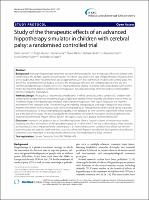Por favor, use este identificador para citar o enlazar este ítem:
https://repositorio.usj.es/handle/123456789/275
Registro completo de metadatos
| Campo DC | Valor | Lengua/Idioma |
|---|---|---|
| dc.contributor.author | Herrero Gállego, Pablo | - |
| dc.contributor.author | Asensio, Ángel | - |
| dc.contributor.author | García, Elena | - |
| dc.contributor.author | Marco, Álvaro | - |
| dc.contributor.author | Oliván-Blázquez, Bárbara | - |
| dc.contributor.author | Ibarz, Alejandro | - |
| dc.contributor.author | Gámez-Trullén, Eva M. | - |
| dc.contributor.author | Casas, Roberto | - |
| dc.date.accessioned | 2020-01-09T09:48:07Z | - |
| dc.date.available | 2020-01-09T09:48:07Z | - |
| dc.date.issued | 2010 | - |
| dc.identifier.citation | Herrero et al., Study of the therapeutic effects of an advanced hippotherapy simulator in children with cerebral palsy: a ran-domised controlled trial BMC Musculoskeletal Disorders 2010, 11:71 | es_ES |
| dc.identifier.issn | 1471-2474 | es_ES |
| dc.identifier.uri | https://repositorio.usj.es/handle/123456789/275 | - |
| dc.description.abstract | Background: Although hippotherapy treatment has been demonstrated to have therapeutic effects on children with cerebral palsy, the samples used in research studies have been very small. In the case of hippotherapy simulators, there are no studies that either recommend or advise against their use in the treatment of children with cerebral palsy. The aim of this randomised clinical study is to analyse the therapeutic effects or the contraindications of the use of a commercial hippotherapy simulator on several important factors relating to children with cerebral palsy such as their motor development, balance control in the sitting posture, hip abduction range of motion and electromyographic activity of adductor musculature.Methods/Design: The study is a randomised controlled trial. It will be carried out with a sample of 37 children with cerebral palsy divided into two treatment groups. Eligible participants will be randomly allocated to receive either (a) Treatment Group with hippotherapy simulator, maintaining sitting posture, with legs in abduction and rhythmic movement of the simulator or (b) Treatment Group maintaining sitting posture, with legs in abduction and without rhythmic movement of the simulator. Data collection and analysis: all measurements will be carried out by a specially trained blind assessor. To ensure standardization quality of the assessors, an inter-examiner agreement will be worked out at the start of the study. The trial is funded by the Department of Research, Innovation and Development of the Regional Government of Aragon (Official Bulletin of Aragon 23 July 2007), project number PM059/2007.Discussion: Interest in this project is due to the following factors: Clinical originality (there are no previous studies analysing the effect of simulators on the population group of children with CP, nor any studies using as many variables as this project); Clinical impact (infantile cerebral palsy is a chronic multisystemic condition that affects not only the patient but also the patient's family and their close circle of friends); Practical benefits (the development of an effective treatment is very important for introducing this element into the rehabilitation of these children).Trial registration: Current Controlled Trials ISRCTN03663478. | es_ES |
| dc.format.extent | 6 p. | es_ES |
| dc.format.mimetype | application/pdf | es_ES |
| dc.language.iso | eng | es_ES |
| dc.publisher | Springer Nature | es_ES |
| dc.rights | Atribución 4.0 Internacional | * |
| dc.rights.uri | http://creativecommons.org/licenses/by/4.0/ | * |
| dc.subject | Parálisis cerebral | es_ES |
| dc.subject | Niños | es_ES |
| dc.title | Study of the therapeutic effects of an advanced hippotherapy simulator in children with cerebral palsy: A randomised controlled trial | es_ES |
| dc.type | info:eu-repo/semantics/article | es_ES |
| dc.subject.unesco | Niño impedido | es_ES |
| dc.relation.publisherversion | https://bmcmusculoskeletdisord.biomedcentral.com/track/pdf/10.1186/1471-2474-11-71 | es_ES |
| dc.identifier.doi | 10.1186/1471-2474-11-71 | es_ES |
| dc.rights.accessrights | info:eu-repo/semantics/openAccess | es_ES |
| Aparece en las colecciones: | Artículos de revistas | |
Ficheros en este ítem:
| Fichero | Descripción | Tamaño | Formato | |
|---|---|---|---|---|
| Study-of-the-therapeutic-effects-of.pdf | 568,56 kB | Adobe PDF |  Visualizar/Abrir |
Este ítem está sujeto a una licencia Creative Commons Licencia Creative Commons

